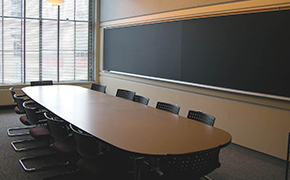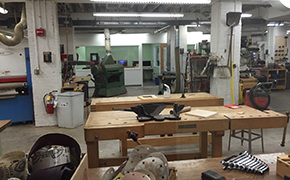This Course at MIT pages are part of the OCW Educator initiative, which seeks to enhance the value of OCW for educators.
Course Overview
This page focuses on the course 21H.343J / CC.120J Making Books: The Renaissance and Today as it was taught by Professors Anne McCants and Jeffrey S. Ravel in Spring 2016.
Part of the Concourse program at MIT, this course explored the impact of new technology on the recording and distribution of words and images at three different times: the invention of the printing press ca. 1450; the adaptation of electricity to communication technology in the 19th century (telegraph, telephone, photograph); and the emergence of digital media today.
Assignments included essays and online projects. Students also participated in the design and construction of a hand-set printing press. Learn more here:
MIT SHASS Communications, “In the MIT History Workshop - where building a printing press illuminates human systems,” SHASS News, May 25, 2016.
Melanie Gonick, “The History of Making Books: Building a Printing Press at MIT,” MIT News, May 25, 2016.
Course Outcomes
Course Goals for Students
- Learn about the history of the book in Europe from Gutenberg (ca. 1450) to the French Revolution (ca. 1800).
- Examine in detail European books and prints from 1450 to 1800 in the Rare Books Collection of the MIT Libraries and the MIT Museum.
- Build a functioning, durable printing press based on Early Modern European designs.
- Consider the parallels between the world of print in the Early Modern period and the rapidly changing media landscape today.
So much learning happens in the hands-on component [of a humanities course] when it is well integrated with the reading, writing, and historical materials because of all the time afforded for spontaneous conversation between faculty and students while engaged with the project.
— Anne McCants
In the following pages, Professors Anne McCants and Jeffrey Ravel describe various aspects of how they taught 21H.343J / CC.120J Making Books: The Renaissance and Today.
Student Insights
The experience of building the press meant I learned new woodshop skills and ideas about design instead of unanchored facts about printing and presses.
— Lauren Huang
In the following pages, Lauren Huang, an Electrical Engineering and Computer Science major, and Theodore Mouratidis, a recent graduate who studied Aerospace Engineering and Physics, describe their experiences as students in 21H.343J / CC.120J Making Books: The Renaissance and Today.
Curriculum Information
Prerequisites
None
Requirements Satisfied
HASS-H ![]()
21H.343J can be applied toward a Bachelor of Science in Humanities and History, but is not required.
Offered
Offered for the first time in Spring 2016
Assessment
The students' grades were based on the following activities:
 20% Class attendance and participation
20% Class attendance and participation 20% Four forum postings
20% Four forum postings 30% Two five-page papers
30% Two five-page papers 30% Building a handset printing press
30% Building a handset printing pressStudent Information

Breakdown by Year
Mostly juniors and seniors
Breakdown by Major
1/2 electrical engineering and computer science majors, 1/2 history majors
Typical Student Background
Prior to enrolling in the course, one student had taken 21H.141 Renaissance To Revolution: Europe, 1300-1800. Another had taken 21H.009 The World: 1400-Present. The rest were new to the material. None of the students had built a printing press previously, and only two were aware of MIT’s Rare Books Collection.
Some of the students were also participants in the Concourse program at MIT. Among other things, the Concourse project engages students in collective deep reading in the humanities and was a critical factor in generating enthusiasm for the course.
During an average week, students were expected to spend 15 hours on the course, roughly divided as follows:
Seminar
- Met 2 times per week for 1.5 hours per session; 13 sessions total; mandatory attendance.
- Class sessions were discussion-based and several included an exploration of items from MIT’s Rare Books Collection.
- A field trip to the MIT Museum enabled students to view visual material dating from 1500 to 1800.
Hands-on Lab
- Met twice a week for 1.5 hours per session; 13 sessions total; mandatory attendance.
- Students worked in the MIT Hobby Shop to design and build a printing press.
Out of Class
- Readings and screenings in preparation for class sessions
- Four forum postings
- Two papers
Semester Breakdown
| WEEK | M | T | W | Th | F |
|---|---|---|---|---|---|
| 1 |  |  |  |  |  |
| 2 |  |  |  |  |  |
| 3 |  |  |  |  |  |
| 4 |  |  |  |  |  |
| 5 |  |  |  |  |  |
| 6 |  |  |  |  |  |
| 7 |  |  |  |  |  |
| 8 |  |  |  |  |  |
| 9 |  |  |  |  |  |
| 10 |  |  |  |  |  |
| 11 |  |  |  |  |  |
| 12 |  |  |  |  |  |
| 13 |  |  |  |  |  |
| 14 |  |  |  |  |  |
| 15 |  |  |  |  |  |
| 16 |  |  |  |  |  |
 No classes throughout MIT
No classes throughout MIT Seminar
Seminar Field trip
Field trip Assignment due
Assignment due No class session scheduled
No class session scheduled MIT Hobby Shop
MIT Hobby Shop Visit from Stephen Skuce, MIT Rare Books Program Manager
Visit from Stephen Skuce, MIT Rare Books Program ManagerCourse Team Roles
I love co-teaching. The conversation between faculty with different points of view, different areas of expertise, or even entirely different disciplinary training, is so much fun for instructors, and so valuable for students. If we want our students to be able to think broadly, and engage with difference productively, the best thing we can do in the classroom is to model how that works.
— Anne McCants
Lead Instructors (Professors Anne McCants and Jeffrey Ravel)
During the first class meeting, the instructors divided the students into two groups. In most weeks, one group met with Professors McCants and Ravel to discuss class readings and examine rare print objects from the MIT collections, while the other group met with Mr. Stone (please see below) to build the printing press. The following week, the groups traded places, such that all students participated equally in the academic and building exercises.
Co-Instructor (Mr. Ken Stone, MIT Hobby Shop Director)
Mr. Stone helped plan the course and supervised the building of the printing press in the MIT Hobby Shop.


 Room 1 of 2
Room 1 of 2 
